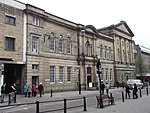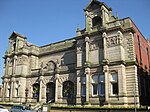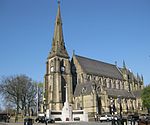Holy Trinity Church, Bury
| Holy Trinity Church, Bury | |
|---|---|
 Holy Trinity Church, Bury | |
| 53°35′20″N 2°17′20″W / 53.5890°N 2.2888°W | |
| OS grid reference | SD 810,103 |
| Location | Bury, Greater Manchester |
| Country | England |
| Denomination | Anglican |
| History | |
| Status | Parish church |
| Architecture | |
| Functional status | Redundant |
| Heritage designation | Grade II |
| Designated | 23 October 2004 |
| Architect(s) | E. G. Paley |
| Architectural type | Church |
| Style | Gothic Revival |
| Completed | 1863 |
| Construction cost | £5,500 |
| Closed | 30 November 2010 |
| Specifications | |
| Capacity | 627 |
| Materials | Coursed rock-faced sandstone with ashlar dressings Welsh slate roofs |
| Administration | |
| Province | York |
| Diocese | Manchester |
| Archdeaconry | Bolton |
| Deanery | Bury |
| Parish | Roch Valley |
Holy Trinity Church is in Spring Street, Bury, Greater Manchester, England. It is a redundant Anglican parish church in the diocese of Manchester.[1] The church is recorded in the National Heritage List for England as a designated Grade II listed building.[2]
History
[edit]The church was built between 1863 and 1865 at a cost of about £5,500 (equivalent to £660,000 in 2023).[3] It was designed by the Lancaster architect E. G. Paley. The original plan included a south aisle and a north tower with a spire, but these were never built. The site was given by the 14th Earl of Derby, who also donated £1,000. As built, the church provided seating for 627 people.[4] The church was extended in about 1920.[2] Edward Hordern, the father of the British actor Michael Hordern, was a rector at the church, likely around the turn of the 20th century.[5] On 30 November 2010 the church was declared redundant,[6] and its parish was merged with those of St Peter, Bury, and St Thomas, Bury, forming the new parish of Roch Valley.[1] As of 2011, it was planned to sell it for use as a children's nursery and an early learning centre.
Architecture
[edit]Holy Trinity Church is constructed in coursed rock-faced sandstone with ashlar dressings. It has Welsh slate roofs. The architectural style is Early English. Its plan consists of a nave, a north aisle with a porch, a chancel with a Lady chapel and a vestry to the north.[2] As the arcade runs down the centre of the church,[2] it is described in the Buildings of England series as a "double-naved church", with "the chancel attached to the south nave".[7] The windows at the east and west ends contain "heavy plate tracery".[7] The arcade has five bays and is carried on round piers.[7] Between the aisle and the Lady chapel is a three-bay arcade.[2] In the Lady chapel is a brightly painted reredos, added in 1987 as a First World War memorial.[7]
See also
[edit]- Listed buildings in Bury
- List of churches in Greater Manchester
- List of ecclesiastical works by E. G. Paley
References
[edit]- ^ a b "A Church Near You". achurchnearyou.com. The Archbishop's Council. Retrieved 4 May 2017.
- ^ a b c d e Historic England, "Holy Trinity Church, Bury (1391180)", National Heritage List for England, retrieved 7 June 2012
- ^ UK Retail Price Index inflation figures are based on data from Clark, Gregory (2017). "The Annual RPI and Average Earnings for Britain, 1209 to Present (New Series)". MeasuringWorth. Retrieved 7 May 2024.
- ^ Brandwood, Geoff; Austin, Tim; Hughes, John; Price, James (2012), The Architecture of Sharpe, Paley and Austin, Swindon: English Heritage, p. 220, ISBN 978-1-84802-049-8
- ^ Hordern, Michael (1993), A World Elsewhere, London: Michael O'Mara Books Ltd, pp. 2–3, ISBN 978-1-85479-188-7
- ^ Diocese of Manchester: All Schemes (PDF), Church Commissioners/Statistics, Church of England, 2010, p. 3, retrieved 7 June 2012
- ^ a b c d Hartwell, Clare; Hyde, Matthew; Pevsner, Nikolaus (2004), Lancashire: Manchester and the South-East, The Buildings of England, New Haven and London: Yale University Press, p. 178, ISBN 0-300-10583-5
- 1863 establishments in England
- Former Church of England church buildings
- Former churches in Greater Manchester
- Grade II listed churches in the Metropolitan Borough of Bury
- Gothic Revival church buildings in Greater Manchester
- Churches completed in 1863
- 19th-century Church of England church buildings
- Church buildings by E. G. Paley
- Edward Smith-Stanley, 14th Earl of Derby




